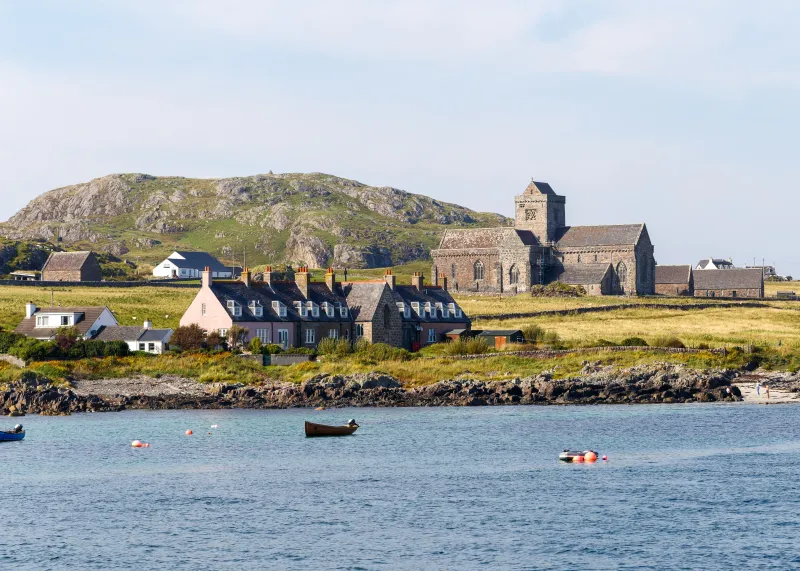
CNA Newsroom, Dec 7, 2022 / 11:00 am (CNA).
More than 1,500 years have passed since the birth of St. Colmcille, one of the trinity of Ireland’s patron saints, along with St. Patrick and St. Brigid. He is a figure of profound religious, cultural, and political significance and is also important to faith groups beyond Catholicism.
In 2021 a series of commemorative events marked 1,500 years since his birth, bringing Colmcille, also known as Columba, and his life, legend, and legacy back into focus.

Niall Comer, director of the Hyde Foundation and lecturer in Irish at Ulster University, explained Colmcille’s enduring significance and appeal: “Colmcille, or ‘the dove of the Church’, has a hugely important part to play in both the religious, political, and social history of Ireland, in particular the northwest and, indeed, in the western isles of Scotland.”
On Iona, a small island on the west coast of Scotland, St. Colmcille settled following his self-imposed exile from Ireland. The story of how an influential figure from the Irish and Celtic monastic tradition found himself in permanent exile in a remote Scottish isle is worthy of a “Name of the Rose” plotline.
Jealous of a psalter owned by St. Finnian, Colmcille secretly copied it so that he could have a replica of his own. Outraged at this early Christian copyright breach, St. Finnian demanded the return of the duplicate. These were the days of illuminated manuscripts, a far cry from printed materials. The work involved in drafting such a psalter would have been both time-consuming and a work of significant beauty. In addition, Colmcille would likely have added his own style to the illuminated copy.
Colmcille refused, arguing that learning and wisdom should be shared, particularly on matters of faith. Adjudicating, the king of Ireland passed down the memorable verdict: “To every cow its calf and to every book its copy.”
This angered Colmcille and thus began a sequence of disputes and battles, leading to the battle of Cúl Dreimhne, in what is modern-day Sligo, and culminating in his self-imposed exile from Ireland in shame, having caused bloodshed. Ireland’s loss was Scotland’s gain.
Comer explained: “Whilst he is mainly associated with the saint’s main foundation on Iona — probably founded around 562 — the monastic institutions he established would later spread throughout Ireland and Scotland, into the north of England, and his cultural influences would reach into the continent.”
I have loved the land of Ireland — I cry for parting. (Colmcille’s Exile)
Despite a life of exile, Colmcille’s appeal endures in the north and northwest of Ireland. Derry derives its name from Doire Colmcille, meaning Colmcille’s oak grove, for he founded a monastery there. In Gartan on Donegal, Colmcille’s birthplace in 521, several sites are directly associated with him. Indeed such is the affection and veneration in Donegal that in preparation for the 1,500 celebrations Bishop Alan McGuckian of Raphoe instituted a Camino-like walking pilgrimage through the county, marking the many sites associated with the saint along the way.

One stop-off point was a small boat trip to the remote windswept Tory Island, located eight miles out to sea in the Atlantic. Anyone who visits Tory typically leaves with an enduring memory of the voyage across a notorious stretch of water. On Tory, Colmcille founded a monastery, the remnants of which are still visible. These include an unusual Tau cross, which is thought to mark a monastic boundary.

Speaking about Tory, Bishop McGuckian said: “There is an ancient Columban heritage on Tory. Tradition has it Colmcille himself founded the monastery on the island.”
In his book “The Waves of Tory,” historian Jim Hunter explains: “In the sixth century St. Colmcille brought Christianity to the island and built a monastery with seven small chapels. There are several ecclesiastical remains from the early Christian era, the most ancient being the church of the seven. Tradition has it that Colmcille endowed the island clay with unique properties to ward off vermin and protect fishermen when at sea.
Comer pointed to the spread of Colmcille’s influence, evidenced by the Irish landscape.
“Place-name evidence of the saint’s influence remains extant in the wider area and stories told of the saint, in particular in ‘Beatha Cholmcille’ (‘The Life of Colmcille’) penned in the 16th century by Mánus Ó Domhnaill, contains a collection of stories which highlight the huge influence which the saint had on many aspects of life in Ireland. A significant cultural legacy is associated with this most influential of characters from Ireland’s history, and his influence has impacted many aspects of Irish life.”

Given the breadth of the Donegal saint’s influence in founding monasteries and his association with illuminated bibles and psalters, painstakingly copied in scriptoria in Colmcille-founded monasteries, it is intriguing to note that St. Patrick’s position as Ireland’s patron was cemented due to political factors: Patrick’s patronage being supported by the O’Neill clan, Colmcille by the less influential Donegal Cineal Conall.
Today Colmcille’s name is etched across Ireland on its landscape. Every visitor to Derry, every tourist who visits Donegal, and every viewer of the Book of Kells is touched by the legacy of St. Colmcille, whether they are aware of it or not. In the seventh century, Beccán, a hermit of Iona, wrote “Last Verses in Praise of Colmcille,” hailing him as wisdom’s champion.
“He possessed books, renounced fully claims of kinship: for love of learning he gave up wars, gave up strongholds,” the hermit wrote.
If you value the news and views Catholic World Report provides, please consider donating to support our efforts. Your contribution will help us continue to make CWR available to all readers worldwide for free, without a subscription. Thank you for your generosity!
Click here for more information on donating to CWR. Click here to sign up for our newsletter.






Leave a Reply